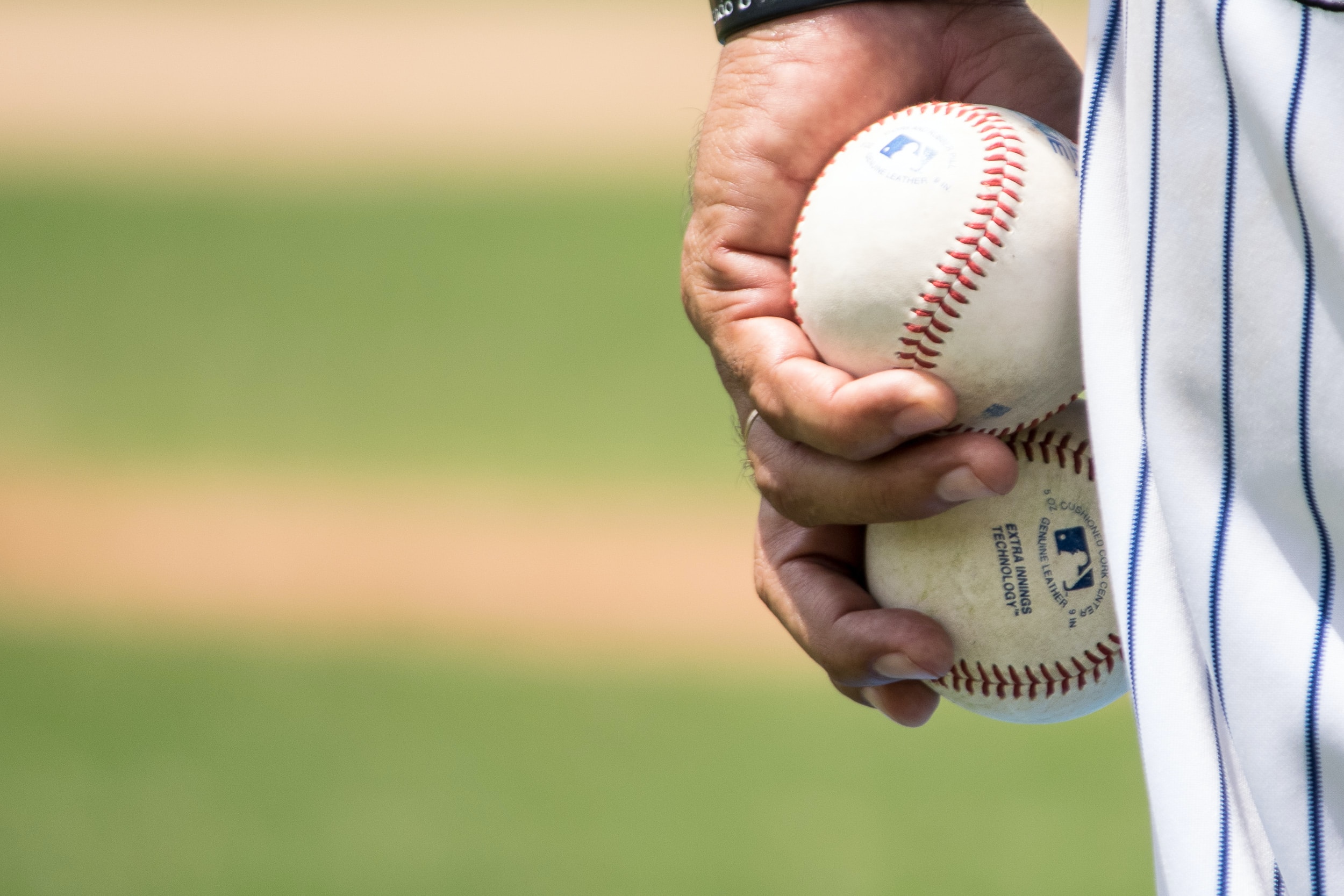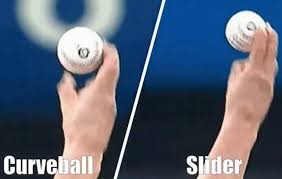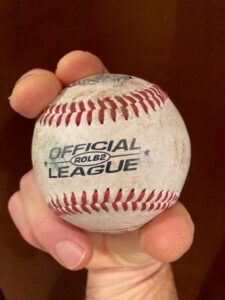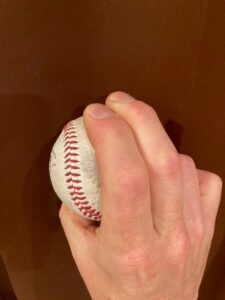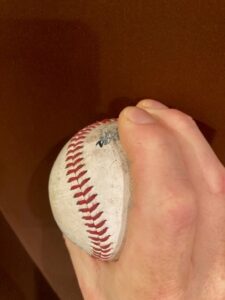In baseball, pitching is an essential component of the game, and mastering various types of pitches can make a significant difference on the field. Among the many pitches that professional baseball players utilize, two prominent examples are the slider and the curveball. Curveball vs. Slider.
Both pitches exhibit unique features, and understanding their distinctions is crucial to upping one’s pitching strategy.
The slider, initially appearing as a fastball, is known for its sharp lateral movement and higher speed relative to the curveball.
Pitchers grip the ball using the index and middle fingers along the horseshoe seam and apply more pressure on one side.
This method generates a lateral spin which creates a sweeping movement either towards or away from the batter. The slider’s unique breaking capability and velocity make it a powerful and preferred option for many pitchers.
On the other hand, the curveball is characterized by its slower speed and greater vertical movement compared to the slider.
The primary difference between the two pitches lies in their grip, which is a vital aspect of delivering the perfect pitch. A curveball’s grip involves placing the fingers closer together on the ball’s seam, generating downward spin and causing the ball to “curve” towards the ground as it approaches the batter.
Contents
Curveball Vs. Slider: A Comparison
| Factor | Curveball | Slider |
|---|---|---|
| Grip | Typically held with the index and middle fingers along the horseshoe seam of the ball | Typically held with the index and middle fingers along the long seam of the ball |
| Spin | Has a topspin rotation that causes the ball to break downward | Has a sidespin rotation that causes the ball to break laterally |
| Movement | Drops sharply as it approaches the plate | Breaks away from the batter’s body |
| Speed | Typically slower than a slider | Typically faster than a curveball |
| Release Point | Typically released with a high arm angle | Typically released with a lower arm angle |
| Difficulty | Can be difficult to master due to the need for precise spin and release | Can be difficult to master due to the need for precise grip and release |
| Popularity | One of the most popular breaking pitches in baseball | Also a popular breaking pitch, but not as commonly used as the curveball |
Movement
The primary difference between curveballs and sliders lies in their movement. A curveball has a more significant vertical break, with the ball dropping down as it reaches the batter. This is due to the pitcher’s wrist snap upon release, resulting in a ball trajectory that appears to defy gravity. On the other hand, sliders have a more lateral movement, turning at the last moment with a sharp, late break.
This movement often deceives batters, as it can resemble a fastball until it breaks away.
Speed
When comparing speeds, sliders are generally faster than curveballs. A typical curveball will have a speed ranging between 70 and 80 miles per hour, while sliders usually fall within the 80 to 90 miles per hour range. However, there are variations within these pitches that can alter their speed:
- Regular Slider: A bit slower (around 8-10 mph) than a fastball, turning at the last moment.
- Hard Slider: Thrown around 2-3 mph faster than a regular slider.
The speed difference between these pitches contributes to the challenge faced by batters when trying to identify and hit them.
Break
Both curveballs and sliders have distinctive breaks that differentiate them from each other. A curveball possesses a looping break, quickly dropping down vertically as it approaches the batter. This break can cause the batter to swing early or under the ball. In comparison, a slider has a tighter and more sudden break, mainly moving horizontally away from the batter. Batters often perceive sliders as fastballs until the ball takes its deceptive and sudden turn.
Spin
The spin of curveballs and sliders is another key difference between the two pitches. A curveball has a top-to-bottom spin, producing its vertical movement, while a slider’s spin is more tilted, like a spinning football, creating lateral movement. The grip a pitcher uses affects the spin:
- Curveball Grip: The pitcher places their index and middle finger along the ball’s seams, using their thumb for support on the opposite side. Upon release, the pitcher snaps their wrist downward, generating the top-to-bottom spin.
- Slider Grip: The pitcher holds the ball with their middle finger along one of the long seams, with the index finger resting beside it. The thumb is placed on the opposite side of the ball, providing support. Pitcher pulls down on the ball during the release, creating a tilted axis spin.
In conclusion, curveballs and sliders are distinct pitches in movement, speed, break, and spin. Each pitch offers unique challenges for batters and requires a specific set of skills for pitchers to execute effectively.
History of Curveball and Slider
The curveball is a pitch that has been around since the early days of baseball. There are multiple origin stories surrounding the creation of the curveball. Some attribute its invention to pitcher Candy Cummings in the 1860s, while others claim that it was developed by either Fred Goldsmith or Clarence Emir Allen. Regardless of who created the curveball, it quickly gained popularity and became a staple pitch for pitchers looking to deceive hitters with a ball that breaks sharply downward.
A few iconic pitchers known for their curveballs include Sandy Koufax, Bob Feller, and Herb Score. Koufax, in particular, had an impressive career, pitching four no-hitters, including a perfect game, and helping the Los Angeles Dodgers win multiple World Series titles. His curveball, said to be one of the best ever, was key to his success.
The slider is a more recent addition to the baseball pitch arsenal. It is believed to have been first used in the 1920s, when it was known as the “Nickel Curve.” Chief Bender, who won 212 games in his career and played in six World Series, is thought to be its originator. The slider evolved as a hybrid between the fastball and curveball, with a tighter spin resulting in a more horizontal movement and less vertical drop. Over time, it gained popularity among pitchers and became another effective weapon for generating swings and misses.
Legendary pitchers like Randy Johnson and Tommy Bridge utilized the slider to great effect during their careers. Johnson, often referred to as “The Big Unit,” was known for his intimidating presence on the mound and dominant slider. His 303 career wins, 4,875 strikeouts, and five Cy Young Awards are a testament to the effectiveness of his slider. Meanwhile, Bridge is another notable pitcher who relied on his slider for success, often baffling hitters with its sharp break.
In conclusion, both the curveball and slider have rich histories in baseball and have been used by some of the game’s greatest pitchers to achieve outstanding results. As the sport continues to evolve, these pitches will likely remain essential tools for those looking to dominate from the mound.
Grip Techniques
Curveball Grip
The curveball grip is a crucial aspect of throwing an effective curveball pitch. To grip a curveball, the pitcher should place their middle and index fingers together across the seams of the baseball. The thumb should be positioned underneath the ball, opposite the index and middle fingers. This grip helps create the necessary spin and movement for the pitch while maintaining control. Some variations on this grip involve different positioning of the middle and index fingers or slightly altering pressure points to create unique break patterns.
It is essential to remember that the grip is only as effective as its ability to create the desired movement. As a pitcher, each person should experiment with variations on this fundamental grip to achieve their ideal curveball.
Slider Grip
The slider grip is another essential aspect for mastering slider pitching. For the slider, a pitcher may use a “slip grip” or “spike grip” depending on their preference. The slip grip involves placing the index and middle fingers close together on top of the ball, with the thumb positioned below, similar to the curveball grip. This grip helps create the tight spin and horizontal movement characteristic of a slider pitch.
The spike grip is an alternative technique that involves slightly lifting the index finger – only the tip of the finger will touch the ball. Remaining pressure comes from the middle finger and thumb. The spike grip can generate more downward movement in addition to the slider’s signature side-to-side motion. It’s important to note that finding the right grip for a slider may take trial and error for each pitcher, as they should explore other variations and maintain the grip that provides the desired movement and control.
In summary, mastering the proper grip techniques for curveball and slider pitches can significantly impact a pitcher’s effectiveness on the mound. Utilizing the right grip for each pitch type is vital to achieve the desired movement, deception, and control.
Pitching Mechanics and Delivery
Release Point
In both curveball and slider pitches, the release point is crucial for achieving the desired pitch movement. For a curveball, the pitcher releases the ball with a more upward wrist motion, allowing the ball to drop vertically as it approaches the plate. In contrast, a slider’s release point involves less upward movement, allowing the ball to achieve more of a sweeping motion, moving both laterally and vertically towards or away from the batter.
Arm Angle
Arm angle plays a significant role in determining the trajectory and movement of pitches. In a curveball, the arm angle is generally more vertical, which contributes to the pitch’s downward movement. For a slider, the arm angle tends to be more of a three-quarters delivery, which helps generate the lateral movement characteristic of the pitch. Understanding the optimal arm angle for each pitch ensures that pitchers achieve the desired pitch motion and deceive batters effectively.
Wrist Action
The wrist action for each of these pitches can also greatly impact the resulting movement of the ball. When throwing a curveball, the pitcher must snap the wrist downward at the point of release, creating the necessary topspin to achieve the desired downward break. For a slider, the wrist action is more of a combination between the curveball and fastball—maintaining some level of pronation to generate lateral spin and movement.
- Curveball Wrist Action:
- Snap wrist downward
- Create topspin for downward break
- Slider Wrist Action:
- Partial pronation
- Generate lateral spin and movement (bullet like or football spiral spin)
Timing
Proper timing is vital to the success of both curveball and slider pitches. For a curveball, the pitcher must ensure that their arm motion, wrist action, and release point all align at the right moment to generate the desired break. In comparison, a slider requires precise release timing to ensure the lateral movement and speed necessary to deceive batters. Consistent practice is necessary for pitchers to perfect the timing of their mechanics for both pitches.
In summary, understanding the pitching mechanics and delivery of both curveballs and sliders is essential to achieving the desired deception and movement. By focusing on the release point, arm angle, wrist action, and timing of each pitch, pitchers can enhance their abilities and increase their chances of success on the mound.
Types and Variations
Basic Curveball
The basic curveball is a pitch in baseball that breaks downward and to the side, using a unique grip and wrist motion. Generally, it has a slower speed than a fastball and more significant drop due to its spin.
12-6 Curveball
A 12-6 curveball is a variation of the basic curveball with a more pronounced drop, resembling the motion between the numbers 12 and 6 on a clock. It’s thrown with a top-to-bottom spin, creating a sharper vertical break.
Regular Slider
A regular slider is a breaking pitch that comes a bit slower (around 8-10 mph) than a fastball but turns at the very last moment. It is thrown with a tighter spin than the curveball, resulting in less vertical drop but more horizontal movement. The spin should be bullet like or football spiral spin.
Cutter
The cutter, or cut fastball, is a pitch that combines the speed of a fastball with the horizontal movement of a slider. It breaks slightly to the side and has a higher velocity than a regular slider, making it challenging for batters to make contact with the ball.
Hard Slider
A hard slider is thrown around 2-3 mph faster than a regular slider. This pitch features a similar horizontal movement to the regular slider but has a slightly higher velocity, making it even more difficult for batters to hit.
Slurve
The slurve is a hybrid pitch that combines elements of both the slider and the curveball. It is thrown with a sweeping, sideways motion and features a break that falls between the curveball’s vertical drop and the slider’s horizontal movement.
Knuckle Curve
The knuckle curve is a variation of the curveball that uses a knuckleball grip. It has a similar break to the basic curveball but is thrown with a unique grip, and the pitcher’s fingers are placed on the ball’s seams, creating a sharper, more unpredictable break.
Cut Fastball
The cut fastball, also known as the cutter, is a pitch that breaks slightly to the side while maintaining the speed of a fastball. It is thrown with a similar grip to a fastball but with a slight off-center pressure applied by the pitcher’s fingers, causing the ball to cut to the side.
Sinker
The sinker is a pitch that breaks downwards with a late, sharp drop as it approaches home plate. It’s thrown with a similar grip to a two-seam fastball but with a slightly different wrist motion, creating a downward movement that makes it difficult for batters to make solid contact.
Effect on Batters and Strategy
The slider and curveball both serve as challenging breaking pitches for batters to hit, as each has a different movement and speed. These pitches are designed to deceive the batter by altering the trajectory of the ball as it approaches the plate.
Sliders break sharply to the side and downward, with less vertical drop but more horizontal movement compared to curveballs. They are typically thrown at a higher velocity, ranging from 85-95 mph. Because of this, batters frequently swing and miss or make weak contact, leading to a higher chance of getting an out for the pitcher. However, if the batter can anticipate the slider’s movement, the increased velocity may lead to harder contact and an increased likelihood of extra-base hits.
In contrast, curveballs have a slower speed of 75-90 mph and a more dramatic downward break.
This movement makes it more difficult for batters to time their swing and make solid contact. The curveball is particularly deceptive when thrown by a pitcher with a consistent release point, as it can be challenging for the batter to distinguish between a fastball and a curveball. Additionally, the greater vertical break can lead to a higher rate of ground balls or pop-ups, which are generally easier to defend.
Pitch selection plays a significant role in keeping the batter off balance.
By mixing sliders and curveballs with fastballs and change-ups, pitchers force the batter to constantly adjust their timing and approach. A strategic use of these pitches can exploit the weaknesses of the opponent and effectively limit their offensive production.
In summary, both the slider and curveball offer unique challenges to batters:
- Sliders: Sharper horizontal movement and higher velocity, resulting in swings and misses or weak contact
- Curveballs: Slower speed and larger vertical break, leading to difficulty in timing swings and an increase in ground balls or pop-ups
Together, these breaking pitches provide a powerful arsenal for the pitcher, increasing their chances of success against any batter.
Practice and Mastery
When it comes to mastering the art of throwing a curveball and a slider, proper practice is essential. With dedication, strategic guidance, and focusing on improving specific skills, players can learn to throw both pitches effectively.
An essential aspect of practicing these pitches is to develop a solid foundation for each. This involves understanding the mechanics behind throwing a curveball and slider, and learning the difference in grip, arm angle, and release points.
- Curveball:
- Grip: Hold the ball with the index and middle finger on the seam, creating tension.
- Arm angle: Keep a higher arm angle, close to the side of the head.
- Release: Throw the ball with a snapping motion, focusing on the top-to-bottom spin.
- Slider:
- Grip: Hold the ball with the index and middle finger along the horseshoe seam, applying more pressure on one side.
- Arm angle: Maintain a lower arm angle, similar to a fastball.
- Release: Throw the ball with a lateral spin, resulting in a sweeping movement.
To master these pitches, players should follow a consistent practice routine. This can include short bullpen sessions, forcing concentration on the drills and gradually increasing the number of pitches thrown.
Working with a knowledgeable coach is beneficial in guiding players through the process of mastering these pitches. Coaches can provide valuable feedback on the mechanics, arm slot, pitch trajectory, and release point, making necessary adjustments to optimize performance.
As players sharpen their skills, they should also focus on implementing strategically timed pitches during games. It’s critical to learn when to throw a curveball or slider, as using them appropriately can keep hitters off-balance and increase the chances of striking out the batter.
In summary, mastering the curveball and slider involves understanding the different mechanics, dedicating time to practice, and learning when to use each pitch. Collaboration with an experienced coach can facilitate the process and help players reach their potential in throwing these breaking pitches.
Injuries and Prevention
Injuries while throwing a curveball or slider can be a significant concern for baseball players. This section will explore the potential risks associated with each pitch, mechanisms of injury, and make suggestions for injury prevention.
Curveball Injuries
Pitching a curveball inherently involves putting stresses on the arm and shoulder. However, studies have shown that the slider causes more injuries than the curveball, particularly in children and adults with prior injuries. However, it’s essential to be aware of the following injuries commonly associated with curveballs:
- Medial elbow injuries or ulnar collateral ligament (UCL) tears
- Shoulder impingement or inflammation
- Growth plate injuries in young athletes
Slider Injuries
Throwing sliders can put more stress on the forearm, wrist, and elbow than curveballs. As a result, the slider could lead to unique injury risks, such as:
- Flexor-pronator mass injuries or strains
- Ulnar (medial) nerve injuries
- Greater risk of UCL tears
Prevention Tips
To minimize injury risks while pitching curveballs or sliders, players should consider the following:
- Prioritize proper pitching technique:
- Emphasize correct grip, release, and follow-through mechanics
- Avoid abrupt, forceful motions or excessive wrist twisting
- Consult with a coach or instructor for personalized guidance
- Implement a structured conditioning program:
- Build sufficient arm and shoulder strength, flexibility, and endurance
- Include core stability and lower body exercises to support arm health
- Include a warm-up and cool-down routine before and after each throwing session
- Monitor workload and prioritize rest:
- Limit the number of pitches thrown and innings played
- Avoid pitching with fatigue or pain
- Allow for appropriate rest and recovery periods between games or practice sessions
- Prevent youth overuse injuries:
- Encourage young athletes to participate in a variety of sports to develop well-rounded musculoskeletal systems
- Refrain from introducing breaking pitches (curveballs and sliders) too early in a child’s development
- Establish age-appropriate pitch count limits and enforce proper rest requirements
By being mindful of the unique risks associated with curveballs and sliders, players can make informed decisions about how to approach these pitches safely and effectively.
Notable Pitchers and Their Pitches
Clayton Kershaw
Clayton Kershaw, a star pitcher for the Los Angeles Dodgers, is well-known for his devastating curveball. Often referred to as “Public Enemy No. 1,” Kershaw’s curveball has become one of the most feared pitches in the league. It has sharp, late break and can deceive batters with its movement.
Randy Johnson
Randy Johnson, one of the most dominant pitchers in the history of baseball and a Hall of Fame member, was famous for his slider. His slider showcased hard, near-impossible-to-hit movement, and it contributed to his career achievements, which include 303 wins and an average of over 10 strikeouts per game. Johnson’s slider earned him five Cy Young Awards during his illustrious career.
Dwight Gooden
Dwight Gooden, or “Dr. K,” was a dominant force in the 1980s, playing for the New York Mets. Gooden was highly regarded for his curveball, which, paired with his fastball, allowed him to strike out a large number of batters. He led the league in strikeouts in his rookie year in 1984 and went on to win a Cy Young Award in 1985, thanks in part to his devastating curveball.
Science and Physics Behind the Pitches
The physics behind a curveball and a slider are essential in understanding how these pitches deceive hitters. Both pitches rely on the Magnus effect, which is a phenomenon that causes a spinning object to create a pressure difference, resulting in a force that causes the object to deviate from its straight path.
A curveball is thrown with significant backspin while the slider has a slightly different spin profile. The pressure difference creates a force that causes the baseball’s trajectory to curve as it travels towards the plate.
Curveball
- Side-spin and backspin combination
- Greater vertical drop due to increased backspin
- Maximum spin efficiency for maximum break
A curveball features a blend of side-spin and backspin, giving it a significant vertical drop as it approaches the plate. By gripping the ball with the middle finger on the seam and the thumb on the opposite seam, the pitcher generates the necessary backspin. The optimal spin axes for maximum curveball break lie between 6 and 7 o’clock when looking at a pitch movement chart.
Slider
- Side-spin and gyroscopic spin combination
- Lateral break with minimal vertical drop
- Faster than curveball, slower than a fastball
A slider showcases a combination of side-spin and gyroscopic spin, which results in a deceptive, lateral break with minimal vertical drop. Most sliders are thrown with a spin axis between 9 and 10 o’clock on a pitch movement chart, producing an effective break. The slider’s delivery employs a mix of fastball and curveball grips, making it faster than a curveball but maintains enough break to confuse hitters.
In both pitches, spin efficiency is crucial in achieving the desired movement. A pitcher with a high spin efficiency is more likely to generate a sharper break on a curveball or a more deceptive slider, making it harder for hitters to predict and hit the ball.
In conclusion, the science and physics behind curveballs and sliders involve the Magnus effect and spin efficiency. Mastery of these aspects is key for pitchers to consistently deliver effective breaking pitches and increase their arsenal against hitters.
Additional Baseball Pitches
Fastballs
Fastballs are fundamental in baseball, primarily thrown to challenge hitters and generate swings and misses or weak contact. There are different types of fastballs, with the most common being the 4-seam fastball. As the name suggests, it is thrown with the pitcher’s fingers across the four seams of the baseball to create maximum backspin, creating a straight and fast pitch. Other fastball variations include the 2-seam fastball, which is gripped along two seams and has more movement, and the cutter, which combines some aspects of a fastball and a slider.
Changeup
The changeup is another essential pitch in a pitcher’s arsenal. It is thrown with a similar arm action and grip as a fastball but at a considerably slower speed. The difference in velocity between the changeup and the fastball can deceive hitters, causing them to swing early and miss or create weak contact. Keys to a successful changeup is maintaining the same arm speed and release point as the fastball while developing the necessary grip and wrist action to reduce the pitch’s speed.
To sum up, a variety of pitches, including curveballs, sliders, fastballs, and changeups, contribute to the complexity and strategy of baseball. Each pitch type serves a distinct purpose and requires skilled execution from the pitcher. By mastering a diverse repertoire of pitches, a pitcher gains a competitive edge over opposing hitters, making the game exciting for both players and fans alike.
Major Leagues and Baseball Fans
In the world of Major League Baseball (MLB), the curveball and slider are seen as formidable and effective pitches. Baseball fans appreciate the art of pitching, especially when it involves the strategic use of curveballs and sliders in games.
The efficiency of a curveball in the MLB typically hovers around 68.7%, making it the second highest. On the other hand, the slider has an efficiency of 35.9%, which is the lowest among pitches. Despite this difference, professional pitchers often dominate their opponents with well-executed curveballs or sliders, thrilling the fans in the process.
One key distinction between these two pitches is their speed!and movement. While the slider is typically thrown at a higher velocity than the curveball, it has less overall movement. This unique combination of breaking capability and speed makes the slider a popular choice among pitchers and an exciting pitch to watch for baseball fans.
In terms of movement, sliders showcase a 42-inch drop with minimal horizontal break. Curveballs, on the other hand, exhibit a whopping 53.6-inch drop along with 9 inches of horizontal break. This dramatic difference in movement makes each pitch uniquely challenging for batters to hit and contributes to the anticipation and exhilaration that baseball fans experience during games.
Here’s a comparison of the two pitches:
| Pitch Type | Spin Efficiency | Velocity | Movement |
|---|---|---|---|
| Curveball | 68.7% | Lower | 53.6-inch drop, 9-inch horizontal break |
| Slider | 35.9% | Higher | 42-inch drop, minimal horizontal break |
In conclusion, both the curveball and the slider are essential pitches in Major League Baseball, captivating the attention of baseball fans not only for their effectiveness in the game but also for their unique attributes. As a result, these pitches continue to play a critical role in the excitement and fascination surrounding the sport.

